Nestled within the coldest regions of our planet, the tundra biome is characterized by extreme cold temperatures, strong winds up to 100 miles per hour and permafrost, a factor that presents a challenging environment for life to thrive. Yet, against all odds, a number of plant species have evolved and adapted to these harsh conditions.
Tundra region is primarily located in the Northern Hemisphere, encompassing the Arctic regions of Alaska, Canada, Greenland, Scandinavia and Russia.
While most of the tundra plants are low-lying, forming dense mats close to the ground, others have evolved into big shrubs. In this article, let us talk about the most common plants this ecosystem harbor.
Facts About Tundra Plants
- The plants are well adapted to the harsh conditions of the tundra, which include long, cold winters, short, cool summers and low precipitation.
- The dominant plant types in the tundra are mosses, lichens, grasses, sedges and dwarf shrubs.
- Many tundra plants are perennials. They survive the long, cold winters by going dormant and regrowing each spring when conditions improve.
- Some tundra plants can even survive temperatures below -50 degrees Fahrenheit.
- The plants are low-growing and have shallow root systems that help them access nutrients from the thin layer of soil above the permafrost.
- They usually have dark-colored leaves or stems.
- Many tundra plants have waxy leaves, which helps to reduce water loss.
- Many tundra plants have hairy or woolly leaves that provide insulation and protect them from freezing temperatures.
- Tundra regions experience very short summers with long daylight hours. The growing season can be as short as 50 to 60 days. Some tundra plants produce vibrant flowers during the brief summer.
- Some plants can reproduce vegetatively by sending out runners that take root and produce new shoots while other plants through seed dispersal.
- The plants provide food and shelter for a variety of animals, including herbivores like caribou, muskoxen and lemmings. These herbivores, in turn, support predators such as wolves, arctic foxes and snowy owls.
- Tundra plants have a low growth rate due to the limited availability of nutrients and the short growing season.
List of Tundra Plants With Their Scientific Names
- Arctic Moss (Calliergon spp.)
- Arctic Willow (Salix arctica)
- Diamond-leaf Willow (Salix pulchra)
- Lapland Rosebay (Rhododendron lapponicum)
- Tufted Saxifrage (Saxifraga cespitosa)
- Arctic Poppy (Papaver radicatum)
- Arctic Bell Heather (Cassiope tetragona)
- Arctic Cotton (Eriophorum scheuchzeri)
- Mountain Avens (Dryas octopetala)
- Moss Campion (Silene acaulis)
- Arctic Willowherb (Epilobium latifolium)
- Arctic Blueberry (Vaccinium uliginosum)
- Reindeer Lichen (Cladonia rangiferina)
- Crowberry (Empetrum nigrum)
- Alpine Azalea (Loiseleuria procumbens)
- Alpine Bistort (Bistorta vivipara)
- Arctic lupine (Lupinus arcticus)
- Arctic Dwarf Birch (Betula nana)
- Snow Buttercup (Ranunculus nivalis)
- Arctic Jacob’s Ladder (Polemonium boreale)
- Arctic Sandwort (Arenaria pseudofrigida)
- Arctic Marsh Marigold (Caltha palustris)
- Mountain Sorrel (Oxyria digyna)
- Labrador Tea Shrub (Ledum groenlandicum)
Description
Arctic moss

Arctic moss, also known as polar moss or tundra moss grows underwater or very low to the ground. On the ground, it forms dense mats or cushions. The dense mats of Arctic moss provide habitat and microclimates for a variety of other organisms (Insects, spiders and other invertebrates).
The mosses also help stabilize the soil, preventing erosion and providing a suitable substrate for other plants to establish themselves. Like all mosses, they have rhizoids instead of roots, they have tiny leaves, usually one cell thick and they do not have flowers.
Arctic Willow

Arctic willow is small, creeping in nature and grows up to 20 centimeters tall with oval shaped pointed leaves covered in long hairs. In the spring it has bright pink flowers that eventually turn into seeds. Its twigs and leaves are eaten by herbivores such as muskoxen, caribou, lemmings and hares, especially during winter when other food sources are scarce.
Arctic willow is one of the first plant species to colonize newly exposed land such as glacial moraines or areas affected by permafrost thawing. Its ability to fix nitrogen from the atmosphere helps enrich the soil for other plant species to establish.
Lapland Rosebay

Lapland rosebay is a Rhododendron species. It is an evergreen prostrate shrub growing to about 18 inches in height with oblong leaves. The flowers are funnel-shaped and occur in clusters at the tips of the branches. They are usually pink in color, but occasionally, they can be lilac or violet blue.
The plant has specialized roots that form a symbiotic relationship with fungi, which help it extract essential nutrients such as phosphorus from the soil. The shrub serves as important cover and nesting habitat for birds and small mammals. It also provides nectar and pollen for pollinators such as bees, butterflies and other insects.
Tufted saxifrage

The tufted alpine saxifrage or tufted saxifrage, is common to many parts of arctic including Greenland, northern Canada Alaska and Siberia. It has a prostrate growth habit characterized by cushion-like tufts.
Tufted saxifrage has evergreen leaves that form compact rosettes. The leaves are usually spoon-shaped and are deep-green in color. The stems are slender, wiry and often reddish-brown in color and they elongate as they age.
This is a slow-growing plant in nature and produces delicate white flowers during the short summer. The plant’s leaves and stems serve as a food source for grazing animals in the arctic.
Arctic Poppy

The Arctic poppy grows to about to 12 inches in height. The stems are slender and hairy stems whereas the leaves are light green and somewhat hairy too. The flowers are solitary with papery petals that can be yellow, white or bright orange. Each flower has a prominent center filled with numerous stamens and pistils.
In Tundra, it is commonly found in meadows, rocky slopes and open areas. As one of the early blooming plants, it provides nectar for early pollinators such as bees and butterflies, for the pollination of other plant species. The plant’s leaves and stems are loved as food by Arctic hares and reindeer.
Arctic Bell Heather

Arctic Bell Heather is grows up to 6 inches in height and commonly grows on ridges and heaths. The stems are woody and covered with fine hair. The shrub sometimes forms dense mats on the ground. The leaves are grooved, evergreen, and scale-like arranged around the stems. They are dark green in color, sometimes turning reddish in cold climates.
The plant bears bell-shaped, solitary flowers usually with white and pink lobes and pink anthers. The flowering occurs in the early summer and lasts for a few weeks. In the arctic, the plant acts as a pioneer species, colonizing bare or disturbed areas, and helping to stabilize the soil.
This plant has what is called a circumpolar distribution, being found in northern parts of North America (including Alaska and Canada), Europe (including Scandinavia and Russia), and Asia (including Siberia).
Arctic cotton

Arctic cotton is one of the most widespread plants in tundra and alpine regions. It has white cotton-like tufts at the ends of its flowering stems and also feature grass-like leaves that are light green in color. The plant forms clumps or tussocks, with individual plants reaching a height of about 12 inches. The tussocks consist of numerous stems arising from a central base.
The plant has ability to reproduce through both seeds and vegetative propagation. But it often spread clonally through rhizomes. The plant is food for caribou, reindeer, snow geese and ptarmigan. It can also be used by humans in making baskets and mats.
Mountain avens
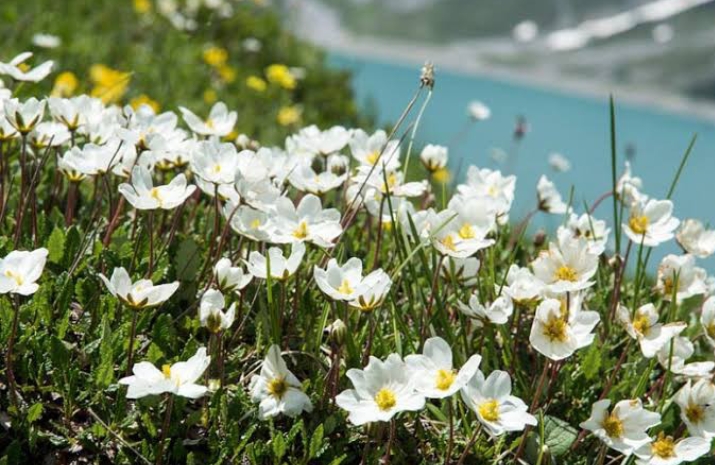
Mountain avens also known as eightpetal mountain-avens or white dryad, is creepy in nature with woody stems that root at the nodes. In tundra region the plant can easily be seen in places where snow melts early, on gravel and rocky barrens.
The plant also features a dense mat of leaves and the flowers are large and have eight creamy white petals with the golden-yellow stamens in the center. The flowers appear often during the summer months.
After pollination, the plant produces achenes, which are small dry fruits containing a single seed. The achenes have feathery-like structures that help in wind dispersal and make the plant to colonize new areas. The Saami people of northern Scandinavia use this plant for medicinal purposes.
Moss campion

Moss campion or cushion pink forms a dense cushion of leaves. It reaches a height of only a few centimeters and the leaves are often gray-green in color. In alpine tundra you can easily spot the plant in places like rocky or gravelly habitats where other vegetation struggle to grow.
The plant produces numerous small, star-shaped flowers that appear in dense clusters atop the cushion of foliage. The flowers are usually pink to purple in color, although white and rarely yellow variations can also be found. The bloom time is often late spring or early summer.
Arctic Willowherb

Arctic Willowherb goes by common names, dwarf fireweed and river beauty willowherb is has lance-shaped leaves, pink to magenta flowers and an extensive underground rhizome system. In tundra, it tends to grow in wet areas such as near rivers, ponds or areas with high water tables.
This plant is an important component of the tundra ecosystem, contributing to the biodiversity and functioning of wetland habitats in this extreme biome. This is a common plant in Scandinavia, across Siberia and Iceland.
Arctic blueberry
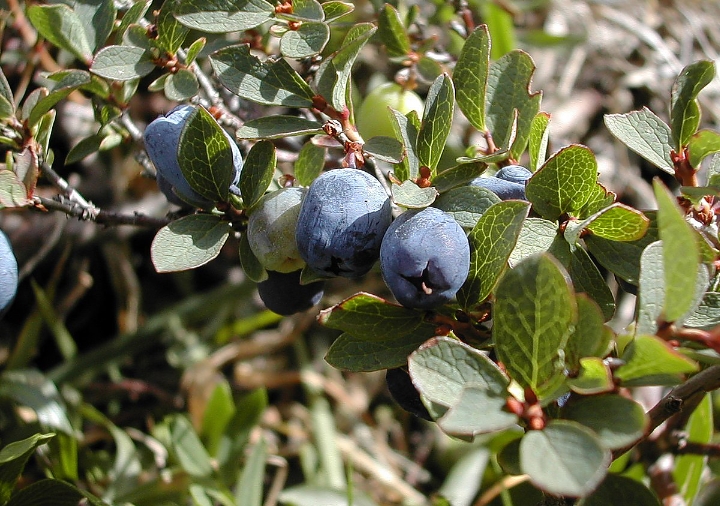
Arctic blueberry also known as bog blueberry, belongs to the same plant family with cranberries and blueberries. It grows to a height of about 24 inches and forms dense, low-lying mats or patches. During autumn, the leaves often turn vibrant shades of red and orange.
This plant produces small white or pink bell-shaped flowers that bloom in clusters. After pollination, the plant develops round berries. The berries start green and gradually ripen to a deep blue or purple color. They are edible and even Birds, such as ptarmigans and thrushes, feed on the berries.
Reindeer lichen

Reindeer Lichen is a specific species of lichen that is loved by reindeer and caribou herds as a food source in the Tundra regions. It is a slow-growing lichen, and it can take up to 10 years for it to reach a size that is large enough to be eaten by reindeer.
This plant is very unique in appearance and consists of branching, antler-like structures. It grows close to the ground in dense mats, covering large areas of the landscape. It is usually gray or pale green in color, but can turn reddish or brownish in autumn.
Crowberry
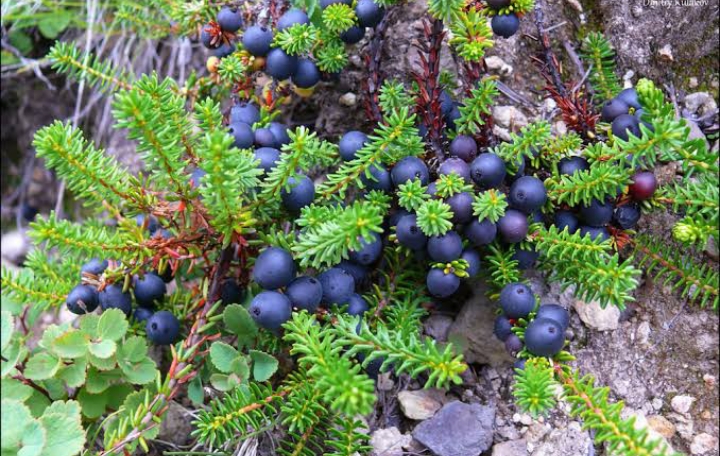
Crowberry grows to about 20 inches in height and forms spreading mats. Its leaves are green in color and the stems are woody and have a reddish-brown hue. This plant can often be seen growing in heaths and alpine meadows in the tundra region.
The berries are fairly large in size and start off green and gradually turn black when ripe. Though they have a somewhat bitter and tart taste. The berries are edible to both wildlife and humans. The berries are particularly loved by birds such as grouse and ptarmigan as well as mammals such as bears and foxes.
Alpine Azalea

Alpine Azalea grows to heights of about 20 inches with prostrate stems and creeping rhizomes that form a mat-like growth pattern. The flowers of this plant are usually seen from May to July. They are bell-shaped and have a pinkish-white to white color and emit a pleasant fragrance.
The nectar-rich flowers attract bees and butterflies, aiding in pollination and supporting the overall biodiversity of the region. In tundra region Alpine Azalea is commonly found in rocky and mountainous regions, often growing in exposed areas or on slopes.
Alpine Bistort
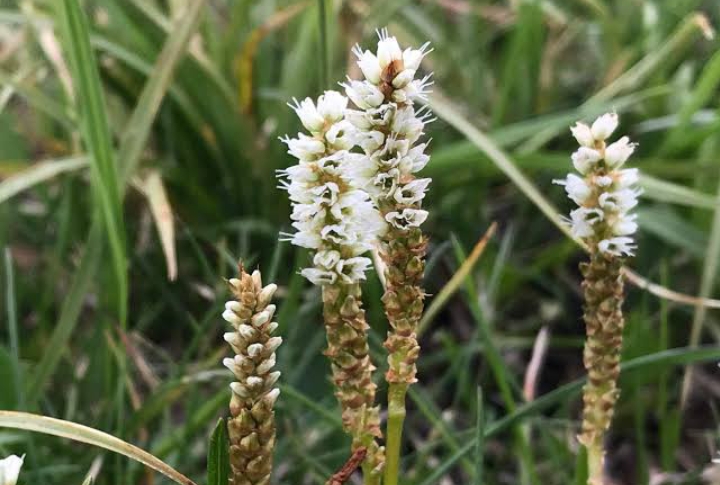
Alpine Bistort commonly referred to as Alpine Knotweed or Viviparous Bistort. It grows to about 6 inches tall and has a thick rhizomatous rootstock and hairless stems. The plant just like many other tundra plants forms dense tufts or mats of basal leaves. The tiny flowers are white or pink in the upper part of the spike and appear between June and July.
Alpine Bistort is commonly found in open, grassy meadows in the tundra. It can also be found growing on rocky slopes, cliffs and outcrops. The Nenets People of northwestern Siberia in Russia have for a very long time used the roots of this plant in traditional medicine.
Arctic lupine
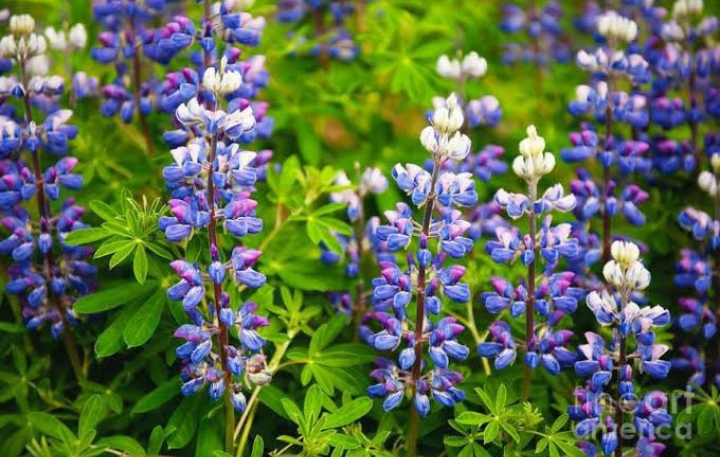
Arctic lupine grows up to about 50 centimeters in height. It has a robust, branching stem with compound leaves that are grayish-green in color, covered with fine hairs. The plant occasionally produces blue or purple flowers, although pink and white variations can also occur. The fruit is a legume pod that contains 4 to 10 seeds.
In tundra you may come across Arctic lupine in the fields of sedge and moss or low-lying areas. In the Canadian Arctic Archipelago, the plant is a common sight on the foothills of mountains. The plant may hybridize with other lupine species when they grow together.
Arctic Dwarf Birch

Arctic Dwarf Birch is a shrub of medium size stature. It grows to a height of about 24 inches, although it can occasionally reach up to 3 feet. It grows by spreading with multiple stems arising from the base. The leaves are a darker green on their upper surface but during autumn, they turn vibrant shades of yellow-orange or red before falling off. Usually, leaf growth occurs after snow melt
The shrub’s leaves and twigs are loved and grazed upon by herbivores like reindeer, muskoxen and hares during the period of the year when other vegetation may be scarce. In places such as Alaska, you can easily observe the Arctic dwarf birch in areas such as sheltered valleys and riverbanks, or in areas where snowdrifts accumulate.
Snow Buttercup

Snow Buttercup grows in a spreading form due to tufts of leaves. The leaves are basal and dark green in color. In general, the plant grows to a height of about 6 inches. The flowers are solitary in nature and yellow in color. The flowers have a bright green center with stamens and pistils.
Snow Buttercup provides nectar and pollen to pollinators such as bees and butterflies, that are active during the short tundra or alpine summer.
Arctic Jacob’s Ladder
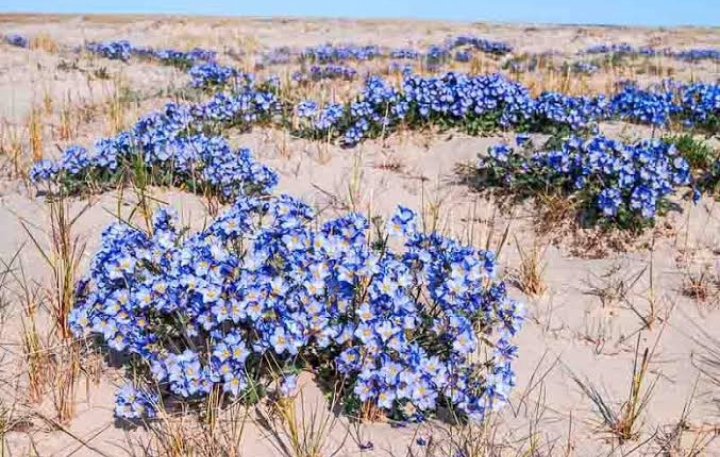
Arctic Jacob’s Ladder has a clumping growth habit. It has multiple stems arising from a central base and grows to about 50 centimeters in height. The leaves are compound in nature and covered in fine hairs.
The flowers of Arctic Jacob’s Ladder are borne in loose clusters at the top of the stems. They actually form a terminal inflorescence. Each flower has blue to lavender petals that are fused at the base. The flowers bloom in the summer and are followed by small, dry fruits. In the tundra regions such as Siberia and Greenland, the plants are common in rocky slopes and in alpine meadows.
The Arctic Sandwort
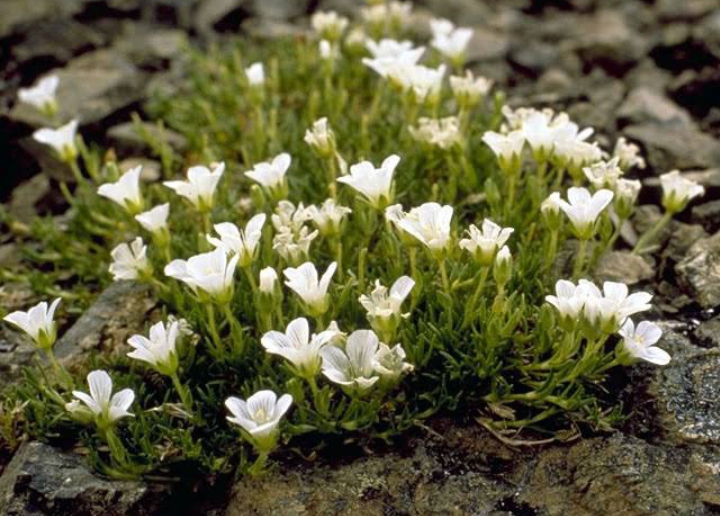
The Arctic Sandwort forms cushions of foliage and grows to about 30 centimeters. The leaves are narrow and linear in shape covered with fine hairs. The flowers are white or pink and are borne in small clusters. They bloom in the short summer months of tundra.
The Arctic Sandwort is among the first plant species to colonize newly exposed land such as glacial moraines or areas affected by permafrost thawing. As an Arctic plant, it serves as a source of food for grazing animals like reindeer, muskoxen and lemmings.
Arctic Marsh Marigold
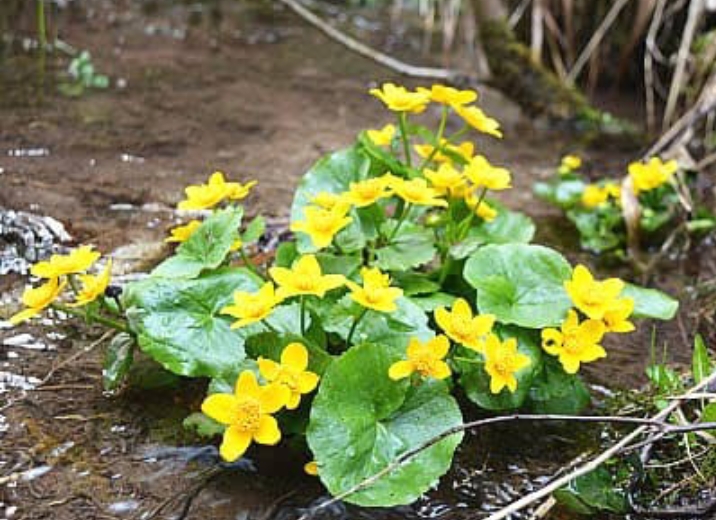
Arctic Marsh Marigold consists of multiple erect stems arising from a basal rosette of dark green leaves. The leaves are kidney-shaped, shiny with a waxy coating. The flowers are bright yellow, usually flowering from April to June, and are pollinated by bees and butterflies.
To effectively survive in tundra and alpine regions. The plant has a fibrous root system that helps anchor it in the saturated soil. The waxy coating on the leaves helps to protects the plant from fungal infections.
Mountain sorrel
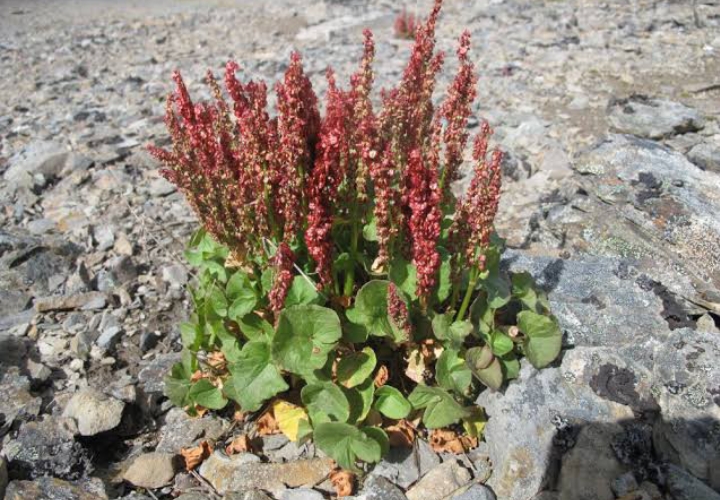
Mountain sorrel is a plant commonly found that is found in the high mountains of tundra region. The plant has slender, reddish stems with heart-shaped leaves that are bright green in color. The plant also produces flowers that are greenish or reddish in color. The flowers are often in dense clusters.
The fruit is a small nut, encircled by a broad wing which finally turns red. This is a slow growing plant and reproduces primarily through vegetative propagation, forming colonies of plants.
Labrador Tea Shrub

This plant grows up to three feet tall and sometimes has multiple stems. The leaves emit a pleasant aroma when crushed or bruised. In spring the plant produces clusters of white to pale pink flowers. The dense shrubby growth offers shelter and nesting sites for birds, small mammals and insects.
The shrub is abundant in the tundra regions of northern Canada, including Yukon, Northwest Territories, and Nunavut. It grows in both the mainland tundra and the tundra areas found on Arctic islands such as Baffin Island. It is also in plenty in areas of northern Russia, such as the Yamal Peninsula and the Taymyr Peninsula.